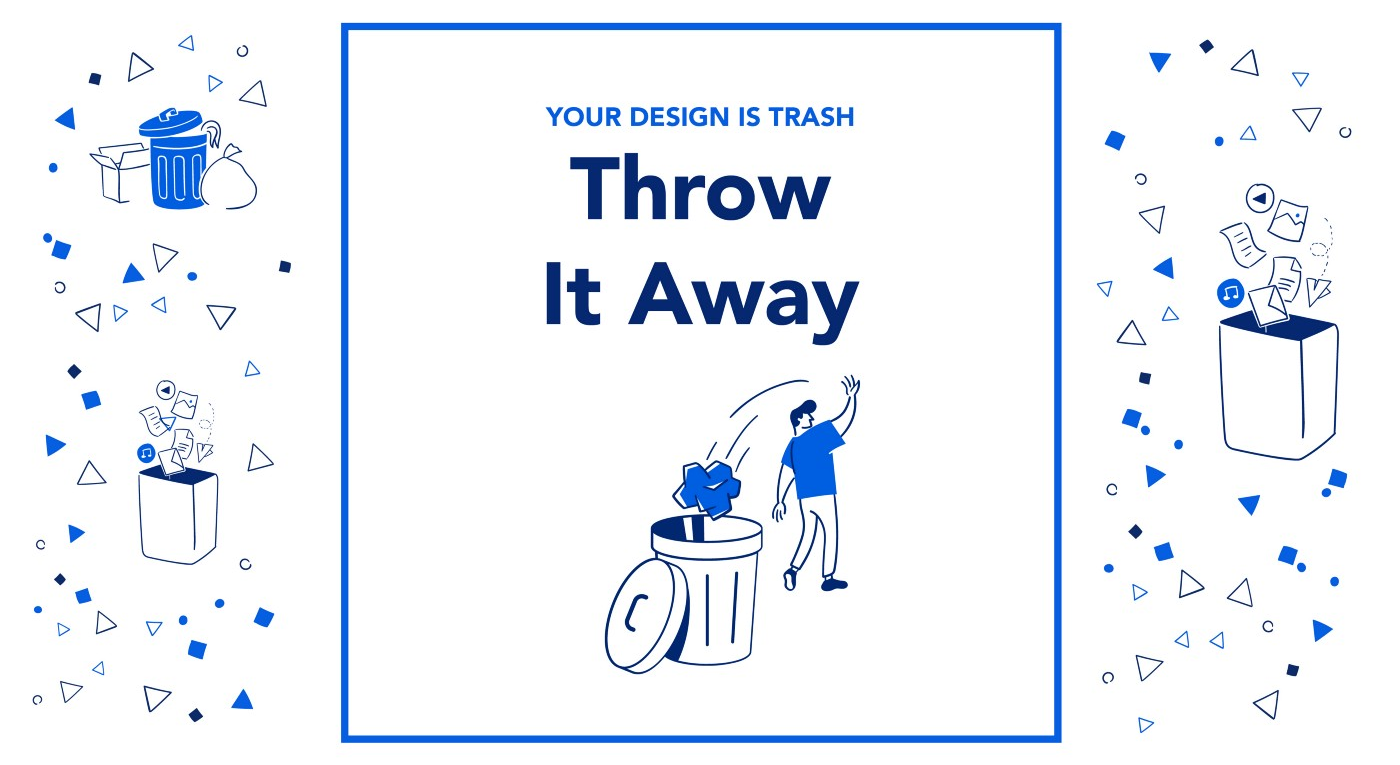Ok, ok, lay down your pitchforks and drop the torches! Your design work is not worthless like trash. Nor does it stink like garbage. But, you do need to get used to throwing it away and quit being so attached.
Let me explain.
User Experience is set apart from other professions by its ability to understand and solve problems for users. This requires exploration, ideation, validation, and a ton of trial and error. This means your job as a designer is marked by doing a bunch of work that never sees the light of day. Design is a process and a journey. Designs that you make are a necessary part of the process of understanding and solving problems. But the value of design is not wrapped up in a single artifact, solution, or deliverable.
The best designers end up throwing away the majority of their work… and they love it! They have design concepts gathering cobwebs in Dropbox that are several years old with multiple versions of projects that no customer ever laid eyes on. Sketches, mockups, and failed ideas are a staple. For these designers, it’s normal for over 75% of their ideas to end up in the metaphorical wheelie bin.
If this seems foreign to you, you are in the right place. I’m here to help you out and share some other signs that you may be too attached to your designs and need to grow in the art of throwing things away:
Signs that you need help
- You don’t want to do project work unless it is guaranteed to ship to customers.
- Ideation is soul-crushing because your work doesn’t get picked to move forward often enough.
- You don’t prototype multiple solutions to a problem space. Side note: I recommend 3–6 approaches to solve a problem.
- You routinely move forward with your first design idea.
- You typically skip research because you are terrified that it will reveal impediments or flaws in your thinking, ultimately derailing your hard work.
- You measure your worth as a designer by your polished deliverables, instead of defining yourself by the process and tradeoffs, it takes to solve problems for users.
- You don’t follow up on your work to see if it met the needs of the users. You may not even have measurements in place.
- If you seek advice or critique, you rarely listen to it because you were looking for affirmation, not correction.
- You are often critical of the work of fellow designers, insisting that you know a better way to do things.
- You are weak at rationalizing your design decisions and get defensive when people question your work. How dare they!
If half (5 out of 10) of these apply to you, then you’ve got some work to do on yourself. If close to all 10 resonate with you, then pay attention to what comes next.
I want to start off by saying you aren’t as great as you think you are. None of us are. Pull up a chair, grab a spot next to me at this table, and let’s eat some humble pie together. It doesn’t taste great, I know, I’ve already eaten a ton myself.
This whole thing boils down to pride. Though, you should have satisfaction and pleasure from your achievements, a little goes a long way. For many designers, it can be detrimental to their careers. This pride shows up through insecurity in your abilities, causing you to be afraid of failure or it shows up through an over abundance of confidence, causing you think you know better than users, colleagues, and stakeholders.
Reasons you need to start tossing things out
Creativity Grows
Getting in the habit of throwing away ideas, coming up with new ones, and thinking about problems from multiple angles gets the creative juices flowing. Nothing helps with creativity more than constantly creating and discarding. If you want to create better designs, get comfortable creating more and throwing most of it away.
“You can’t use up creativity. The more you use, the more you have.” — Maya Angelou
I have found that going through this process allows me to get to some of my best ideas. Your first idea is rarely the best, so keep creating, and toss out the rest.
Rationale Grows
Designing multiple solutions to a problem forces you to think about things from different perspectives. This practice naturally gives you the ability to talk through the different options and explain why you chose one direction over another. This is at the core of innovation; working in different spaces, exploring different opportunities, and the like. When you take the time to do this work, you will understand design more because you’ll actually be designing. Crazy, I know!
“Where you innovate, how you innovate, and what you innovate are design problems.” — Tim Brown, CEO and president of IDEO
You’re Missing The Point!!
Being a designer isn’t about a single artifact, project, or deliverable. It’s not only about the deliverables. It is a process! Your artifacts, mockups, low-hi, and hi-fi designs can and should be used in exploration, ideation, presenting ideas, explaining tradeoffs, and ultimately getting to the right solution. The is design. If you are still holding on for dear life to your ideas themselves, you’re still not understanding what this whole design thing is all about.
“Design is not a single object or dimension. Design is messy and complex.” — Natasha Jen, designer and educator
Old Ideas Age Well
A few years back I poured my heart and soul into a solution to a problem. With conviction, I advocated for it. Ultimately, the company went in another direction. So I set my mockups, prototypes, user flows, and such in a DropBox folder. 5 years later the company began working in a direction parallel to my old design work. I was able to pull out those old designs and help shape the direction. Plus, I felt validated for my conviction from years ago. Just because a design solution doesn’t move forward today doesn’t mean it won’t move forward tomorrow. Designers are always thinking in the future and in the next larger context. Don’t be surprised if it takes a few years for others to catch up.
Design Artifacts Have Multiple Purposes
I’ve said this in a couple of other places, but I want to summarize it and say it again: Your design work is not just about deliverables. Here are some other practical applications for design work:
- Build consensus with stakeholders. Artifacts communicate more than words.
- Use alternate design approaches to discuss trade-offs. When debating alternate paths, just mockup the different options to discuss the trade-offs.
- Test out different approaches with users to see which are more effective at solving problems.
- Rejection helps us to know what colleagues, stakeholders, and leaders are looking for.
Amateur Designers Get Attached
Amateurs stop iterating too soon. Professionals iterate as much as it takes to create something great. Amateur designers may not understand that the best design work requires multiple iterations and failed ideas. Sometimes you get to the good ideas after a few attempts, sometimes it takes a lot more.
“The alternative to good design is always bad design. There is no such thing as no design.” — Adam Judge, author
Gotta Break Some Eggs
Getting to the best ideas requires cycling through some uggos and breaking a few eggs. If it helps, think of your designs as disposable artifacts, assisting in you uncovering golden nuggets.
“It’s through mistakes that you actually can grow. You have to get bad in order to get good.” — Paula Scher, graphic designer and painter
Putting all this into practice
When I first came to Covenant Eyes my manager had this exercise for the UX team. We would each get a piece of paper and a pen/pencil. He would give us a design challenge and then give us some time to work on a solution. The first time I did this, I put a lot of effort into it. I wanted to impress. After the time was up, we came back together and shared our ideas. I was so proud of myself. I felt great! Next, he told us to take that piece of paper, with our sharpie sketch, crumple it up, and throw it into the trash. “Now, do it again” he’d say. We had to come up with another idea. It had to be a completely different approach to the problem. It was jarring at first. But after a few times, I noticed my ideas were getting better. He ended up using this exercise many times over the years. Design problems, discussions around strategy, and any area where it applied were often hashed through with this exercise.
You can do it too
- Go to https://sharpen.design/ and get a practice design prompt.
- Design a solution.
- Throw it away.
- Repeat steps 2 and 3 a few times.
This is something you can do by yourself or with a group of designers. Have fun and trash some designs.








